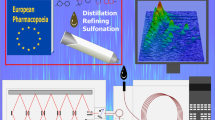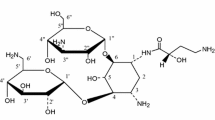Abstract
Zidebactam (ZID), a novel β-lactam enhancer drug being developed to treat infections caused by Gram-negative bacteria, currently is in phase III clinical development. Two ionic impurities observed in liquid chromatography with charged aerosol detector (CAD) analysis were identified through liquid-chromatography mass spectrometry (LC–MS) as sulfate (SO−24) and monomethyl sulfate (CH3OSO−13, MMS). There genesis was attributed to the use of pyridine sulfur trioxide as a reagent in ZID synthesis. A new chromatographic method using mixed-mode stationary phase and CAD was developed and validated. The separation of ionic impurities was achieved on Obelisc-N column using buffer gradient. The new method was found to be simple, specific, sensitive, precise, accurate and robust for controlling these impurities in new drug substance. Accuracy of the method was verified by comparing the results with that of ion chromatography (IC) with conductivity detector. The IC method was employed to monitor the impurities in ZID drug substance used for clinical trials and stability analysis.
Graphic abstract







Similar content being viewed by others
References
Joshi SN, Jadhav SB, Bhawsar SS, Deshpande PK, Yeole RD, Patel MV (2015) A process for preparation of (2S,5R)-7-Oxo-6-sulphooxy-2-[N’-((3R)-piperidin-3-carbonyl)-hydrazinocarbonyl]-1,6-diaza-bicyclo[3.2.1]octane. World Intellectual Property Organization: International application published under the patent cooperation treaty (pct), Publication Number WO 2015110885A1
Sader HS, Castanheira M, Huband M, Jones RN, Flamm RK (2017) WCK 5222 (cefepime-zidebactam) antimicrobial activity against clinical isolates of Gram-negative bacteria collected worldwide in 2015. Antimicrob Agents Chemother. https://doi.org/10.1128/AAC.00072-17
Sader HS, Rhomberg PR, Flamm RK, Jones RN, Castanheira M (2017) WCK 5222 (cefepime-zidebactam) antimicrobial activity against clinical isolates of Gram-negative organisms producing clinically relevant-lactamases. J Antimicrob Chemother. https://doi.org/10.1093/jac/dkx050
Livermore DM, Mushtaq S, Warner M, Vickers A, Woodford N (2017) In vitro activity of cefepime/zidebactam (WCK 5222) against Gram-negative bacteria. J Antimicrob Chemother. https://doi.org/10.1093/jac/dkw593
Moya B, Barcelo IM, Bhagwat S, Patel M, Bou G, Papp-Wallace KM, Bonoma RA, Oliver A (2017) WCK 5107 (zidebactam) and WCK 5153 are novel inhibitors of PBP2 showing potent “β-lactam enhancer” activity against Pseudomonas aeruginosa, including multidrug-resistant metallo-β-lactamase-producing high-risk clones. Antimicrob Agents Chemother. https://doi.org/10.1128/AAC.02529-16
Moya B, Barcelo IM, Bhagwat S, Patel M, Bou G, Papp-Wallace KM, Bonoma RA, Oliver A (2017) Potent β-lactam enhancer activity of zidebactam and WCK 5153 against Acinebacter baumannii, including carbapenemase-producing clinical isolates. Antimicrob Agents Chemother. https://doi.org/10.1128/AAC.01238-17
Vehoveca T, Obreza A (2010) Review of operating principle and applications of the charged aerosol detector. J Chromatogr A. https://doi.org/10.1016/j.chroma.2010.01.007
Shirota Osamu (2010) Charged aerosol detection (CAD): a new universal approach for HPLC. Foods Food Ingredients J. Jpn. 215(2):144–153
Paul HG (2017) Charged aerosol detection for liquid chromatography and related separation techniques. Wiley Online Library. https://doi.org/10.1002/9781119390725
Stypulkowska K, Blazewicz A, Fijalek Z, Warowna-Grzeskiewicz M, Srebrzynska K (2013) Determination of neomycin and related substances in pharmaceutical preparations by reversed-phase high performance liquid chromatography with mass spectrometry and charged aerosol detection. J Pharm Biomed Anal. https://doi.org/10.1016/j.jpba.2012.12.025
Almeling S, IIko D, Holzgrabe U (2012) Charged aerosol detection in pharmaceutical analysis. J Pharm Biomed Anal. https://doi.org/10.1016/j.jpba.2012.03.019
Karol W, Anna P, Tomasz T, Dominika P, Grzegorz B, Patrycjusz K, Piotr T (2019) Comparison of various chromatographic systems for analysis of cytisine in human serum, saliva and pharmaceutical formulation by HPLC with diode array, fluorescence or mass spectrometry detection. Molecules. https://doi.org/10.3390/molecules24142580
Dennis J (2011) Application of Ion Chromatography in Pharmaceutical and Drug Analysis. J Chromatogr Sci. https://doi.org/10.1093/chrsci/49.7.524
Siddiqui MR, AlOthman ZA, Rahman N (2017) Analytical Techniques in Pharmaceutical analysis A review. Arab. J. Chem. https://doi.org/10.1016/j.arabjc.2013.04.016
ICH (1999) Q6A specifications: Test procedures and acceptance, criteria for new drug substances and new drug products: chemical substances. In: International conference on harmonization of technical requirements for registration of pharmaceuticals for human use. http://www.ich.org
ICH (2005) Q2(R1) Validation of analytical procedures: text and methodologies. In: International conference on harmonization of technical requirements for registration of pharmaceuticals for human use. http://www.ich.org
Acknowledgement
Authors thank to management of Wockhardt Limited for supporting this work.
Funding
Authors thank the management of Wockhardt Limited for funding to conduct this work.
Author information
Authors and Affiliations
Corresponding author
Ethics declarations
Conflict of Interest
The authors declare that there is no conflict regarding publication of this manuscript.
Research Involving Human or Animal Participants
This article does not contain any studies with human participants or animals performed by any of the authors.
Additional information
Publisher's Note
Springer Nature remains neutral with regard to jurisdictional claims in published maps and institutional affiliations.
Rights and permissions
About this article
Cite this article
Ahirrao, V.K., Rane, V.P., Patil, K.R. et al. Identification of Monomethyl Sulfate and Sulfate Impurities in Zidebactam Using LC–MS and Application of Mixed-Mode Liquid Chromatography with Charged Aerosol Detection and Ion Chromatography for Quantification. Chromatographia 83, 219–228 (2020). https://doi.org/10.1007/s10337-019-03836-4
Received:
Revised:
Accepted:
Published:
Issue Date:
DOI: https://doi.org/10.1007/s10337-019-03836-4




